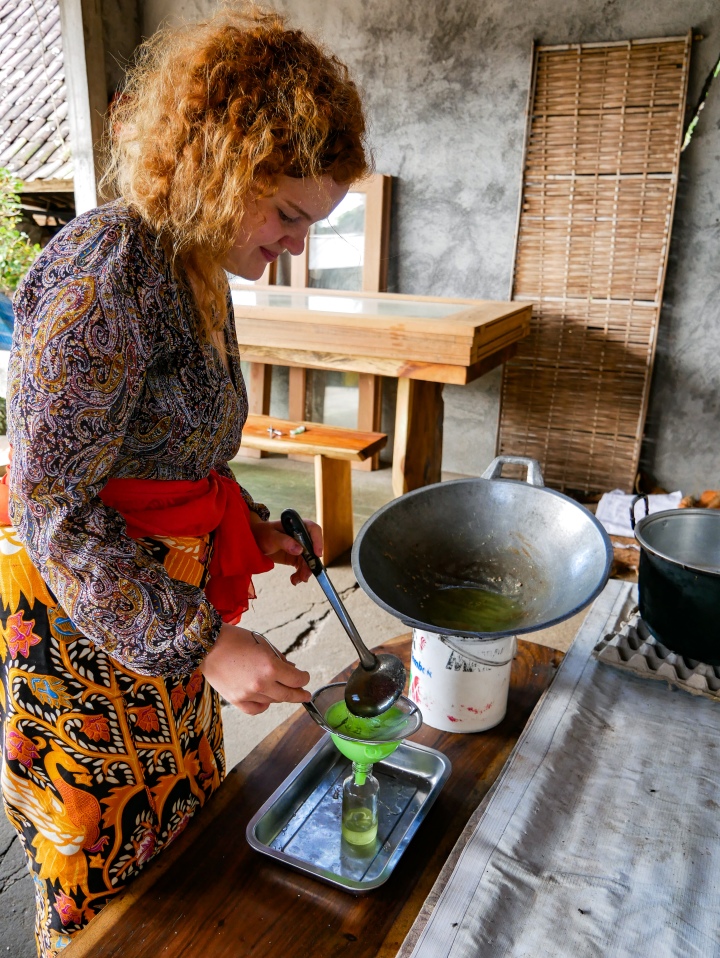
We use all sorts of exotic oils and lotions and products in Europe, but they come to us nicely packed and prepared so that we don’t need to do anything except enjoy. That’s amazing and clearly saves time and energy, but coconut oil jars or chicken wings don’t grow on trees. There’s always somebody somewhere doing something for them to get to our superstores. Obviously, most products we have are industrially machine-made, so not every coconut is individually processed by an actual person to to make our coconut oil, but before the machines, there has been handcraft for centuries, which is still used by people all over the world. And thank heaven it is, because otherwise all those traditions, know-how and cultural heritage would be forever lost in history.
I believe that if we know where the products you use come from we can enjoy them more and make more mindful decision regarding the products we use. One example I sometimes use, which I know is quite controversial, is that if you eat meat, you should at least once see how the process of a steak is from beginning to end. Because the finished product really is only a result, which takes time, effort and in some cases, sacrifice. This works for everything we consume, from food to clothing and anything else. It’s sometimes hard to figure out the process because you can’t just walk in a factory on the other side of the world and the transparence of brands is often more than questionable, but whenever you have the opportunity to go to the roots of making a product – whether it is a yogurt factory or traditional art in a small village in Indonesia – you should do it.
During my stay in Bali, I got the opportunity to learn how to make a product most people are familiar with as it’s been super hyped for a few years: coconut oil. Obviously, there are many methods for making coconut oil, but I got to see how it is made in a traditional Balinese home. The experience turned out to be very enlightening in many ways, as in addition to learning the process of making coconut oil, I also learnt a lot about local life and culture from the family whose house I visited.
There are two types of coconuts used on the island: green ones and yellow ones. Green ones are better for edible use, including coconut oil. The coconut has to be a few months old, as the young ones don’t have enough meat and is too soft. The first phase consists of simply cutting the coconut, draining it of water and taking the shell off. It all looks easy and fun when you watch a man who has been doing it since he was a kid, but when you take that huge knife in your hand, it feels like it’s going to take your whole arm to get a bit of oil.


After the fight with the shell, the meat- which is clearly thicker and harder than the one of fresh coconuts, is grated, then mixed with the coconut water and water. The grated meat is drained through a cheese cloth and the liquid put on the stove for about 10-15 minutes. At this point, we added a piece of fresh turmeric root in the pan. It gives a nice taste and smell, has health properties, and helps separating the coconut oil from the milk as it colours the oil yellow but leaves the milk white.




When the mixture is boiling enough, it’s taken off the stove and we started separating the oil on the surface from the milk by taking spoonfuls of the oil on the surface, blowing on it gently to push the oil off and putting the milk back in a separate pan. Then the oil is back on the stove, until the remaining milk has firmed up so it’s easy to separate from the now pure oil. That solid coconut milk tastes heavenly, by the way. It’s like candy, and apparently often used to fry vegetables for example.




The final step is simply filtering the oil once before bottling to make sure there is nothing else remaining but oil, and there you go, the oil is ready for use. I can’t wait to get in the kitchen myself to test it. It was such a pleasure to meet the lovely family running this business, you can check what they do on Instagram if you’re in Bali and interested in making your oil as well!

Memang sangat banyak di Indonesia pohon kelapa, bisa dibikin segala macem..
LikeLike
I hope Google translated this the correct way, but that’s true, there’s a lot of coconut in Indonesia, and so many things can be made out of it. I’ve seen a lot of that, both in the workshop and in Bali in general!
LikeLike
Sangat segar bukan coconut in Indonesia, bay Im from Indonesian….
Visiting to Indonesian is very happiness
LikeLike